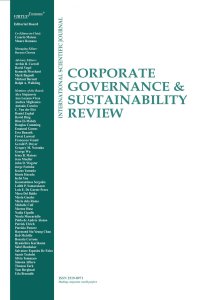New issue of the Corporate Governance and Sustainability Review journal

The editorial team of Virtus Interpress is delighted to introduce the third issue of 2022 of the journal “Corporate Governance and Sustainability Review”. The papers in this issues deal with different corporate governance and sustainability topics such as corporate governance, financial institutions, regulation, Dodd-Frank Act, systemic risk, auditor independence, guanxi, economic reform, Neo-Durkheimian theoretical framework, stakeholder engagement, antecedents and consequences, firm-stakeholder relations, green construction projects, risk management, interpretive structural modelling, corporate social responsibility, CSR impact assessment, CSR implementation, and CSR governance.
In the first paper, Mark Swanstrom examines whether the corporate governance of financial institutions with assets just below the $10B asset threshold affected their willingness to cross that threshold. Results indicate that firms with staggered boards and smaller boards took longer to cross the threshold while higher levels of ownership by the chief executive officer (CEO) resulted in faster crossings. Financial institutions were much quicker to pass the threshold in the later years of the study due to changes in the economic and regulatory environment.
Wenqi Han and Michelle Cull’s study builds on the work of Durkheim (1915) by applying a neo-Durkheimian theoretical framework to audit failure in China following the implementation of economic reform and international auditing standards to highlight how embedded cultural norms, such as guanxi, limit adaptation and influence auditor independence. Specifically, this study adopts the grid-group dimensions to assist in understanding how Chinese auditors interpret their social relations based on cultural beliefs and overlaid them with characteristics of Chinese culture to demonstrate the influence of guanxi. The neo-Durkheimian theoretical framework used in this study may be extended to examine auditing practices in other emerging economies across a range of cultures, and may also be relevant to other areas of professional practice.
The next paper by Avinash Pratap Singh and Zillur Rahman has two unique properties: first, it consolidates the knowledge of the antecedents and consequences of SE processes to generate a holistic view of the firm-stakeholder relationships. Second, it explores the existence of business practices in instrumental and normative dimensions using the concept of “continuum” to provide deeper insights into the SE processes. The authors used thematic analysis to provide evidence of the growing interest of academics and managers in firm-stakeholder engagement. The findings of this study suggest that shared benefits with a long-term perspective are valuable to both corporation and its stakeholders.
The objectives of the study by Abhishek Mojumder, Amol Singh, and Sunil Luthra are to identify the correlation of the risks with organizational sustainability and model development for risk mitigation. Semi-structured interviews, Spearman rank correlation, regression analysis, and interpretive structural modelling (ISM) have been used as research methods. Results show a strong negative correlation between the risks with sustainability, the environment as the most significant sustainability driver, and an integrated risk management model is developed. The study benefits construction project managers in more systematic and structured thinking towards relating the green construction risks with sustainability, understanding the sustainability drivers and managing the risks through the integrated risk management model thus successful project execution ensuring organizational sustainability.
The final paper by Avadhesh Dixit and Himani Mishra aims to provide a comprehensive framework that enables CSR activity identification, implementation, and impact assessment for an organization, considering the perspectives of important stakeholders in the CSR activity. First, the paper reviews the research literature related to CSR and CSR impact assessment and proposes a framework that addresses the research gaps found in the literature. The five-step framework for CSR activity identification, implementation, and impact assessment infuses the stakeholder perspective. It identifies the broad parameters that can be used to assess the impact of the CSR activity. Suggested criteria entail qualitative and quantitative evaluation practices, thus ensuring holistic impact assessment. The framework will enable transparent reporting of CSR expenditure and ensure disclosure of the actual impact made by CSR at the ground level. The accountability in reporting through the framework will curb CSR washing and decoupling. The stakeholder perspective emphasizing CSR beneficiaries and the impact assessment parameters provide a novel way of implementing and assessing CSR activity.
The full issue of the journal is available at the following link.
We wish you pleasant and informative reading!
















